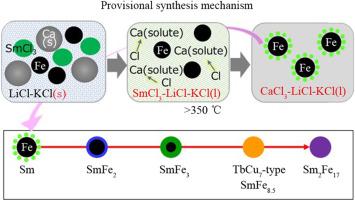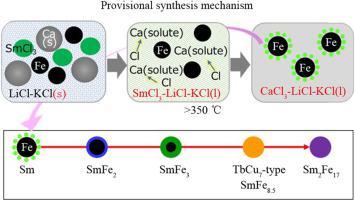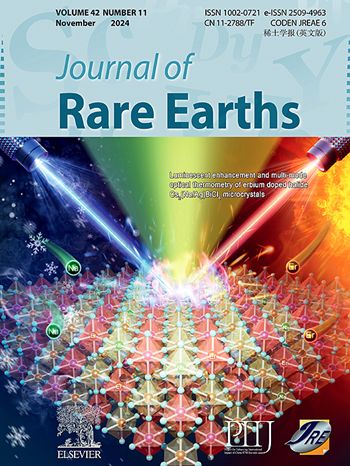Mechanism of reduction-diffusion reaction in Sm–Fe binary system at low temperature using molten salts
IF 5.2
1区 化学
Q1 CHEMISTRY, APPLIED
引用次数: 0
Abstract
In this study, the mechanism of the reduction-diffusion reaction in a Sm–Fe binary system at low temperature was studied to investigate the possibility of synthesis of a Fe-rich TbCu7-type SmFex (x > 9) by the low-temperature diffusion-reduction (LTRD) process using LiCl–KCl eutectic molten salts. Firstly, the Sm–Fe phase transformation depending on the Sm–Fe composition, the LTRD temperature, and time was investigated, and it is found that the obtained metastable phase is only TbCu7-type SmFe∼8.5, which is not a Fe-rich phase. This Fe content does not change even after an expended LTRD process, and the metastable TbCu7-type SmFe∼8.5 tends to transform to the stable Sm2Fe17 phase. In addition, it is found that the Sm–Fe phase starts to synthesize from the Sm-rich phase in the order of SmFe2, SmFe3, and SmFe8.5 as the LTRD temperature increases (when the time was 10 h) or the LTRD time increases (when the temperature was 550 °C). Core-shell-like particles are observed in the case of a short LTRD time, and the core and the shell are Fe and the Sm-rich Sm–Fe phase, respectively, indicating that the Sm-rich phase begins to produce on the surface of the Fe particles. It is difficult to synthesize a Fe-rich TbCu7-type SmFex (x > 9) phase with the Sm–Fe binary system, suggesting that a different approach, such as addition of other elements, will be necessary.


低温下利用熔盐在 Sm-Fe 二元体系中进行还原-扩散反应的机理
本研究研究了低温下Sm-Fe二元体系中的还原-扩散反应机理,探讨了利用LiCl-KCl共晶熔盐通过低温扩散-还原(LTRD)过程合成富Fe的TbCu7型SmFex(x >9)的可能性。首先,研究了 Sm-Fe 相变取决于 Sm-Fe 成分、低温扩散还原温度和时间,发现得到的阶跃相仅为 TbCu7 型 SmFe∼8.5,并非富铁相。这种铁含量即使在消耗 LTRD 过程后也不会发生变化,而且逸散的 TbCu7 型 SmFe∼8.5 趋向于转变为稳定的 Sm2Fe17 相。此外,随着 LTRD 温度的升高(当时间为 10 小时时)或 LTRD 时间的延长(当温度为 550 ℃ 时),Sm-Fe 相开始按照 SmFe2、SmFe3 和 SmFe8.5 的顺序从富 Sm 相合成。在 LTRD 时间较短的情况下,可以观察到核壳状颗粒,核和壳分别是铁和富含 Sm 的 Sm-Fe 相,这表明在铁颗粒表面开始产生富含 Sm 的相。Sm-Fe二元体系很难合成富含Fe的TbCu7型SmFex(x >9)相,这表明需要采用不同的方法,如添加其他元素。
本文章由计算机程序翻译,如有差异,请以英文原文为准。
求助全文
约1分钟内获得全文
求助全文
来源期刊

Journal of Rare Earths
化学-应用化学
CiteScore
8.70
自引率
14.30%
发文量
374
审稿时长
1.7 months
期刊介绍:
The Journal of Rare Earths reports studies on the 17 rare earth elements. It is a unique English-language learned journal that publishes works on various aspects of basic theory and applied science in the field of rare earths (RE). The journal accepts original high-quality original research papers and review articles with inventive content, and complete experimental data. It represents high academic standards and new progress in the RE field. Due to the advantage of abundant RE resources of China, the research on RE develops very actively, and papers on the latest progress in this field emerge every year. It is not only an important resource in which technicians publish and obtain their latest research results on RE, but also an important way of reflecting the updated progress in RE research field.
The Journal of Rare Earths covers all research and application of RE rare earths including spectroscopy, luminescence and phosphors, rare earth catalysis, magnetism and magnetic materials, advanced rare earth materials, RE chemistry & hydrometallurgy, RE metallography & pyrometallurgy, RE new materials, RE solid state physics & solid state chemistry, rare earth applications, RE analysis & test, RE geology & ore dressing, etc.
 求助内容:
求助内容: 应助结果提醒方式:
应助结果提醒方式:


